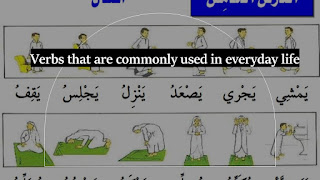Daily Arabic Verbs | Fi'l Madi | Fi'l Mudari
Let's learn verbs (أَفْعَالٌ ) that are commonly used in everyday life.
The first form of verbs we are going to learn is the root verb.
The root verb is verb form for 3rd person masculine singular (ghaib mudhakkar mufrad) or غائب مفرد مذكّر
We will learn both fi'l madi (فعل الماضي) and fi'l mudari' (فعل المضارع).
The source book is تَعْلِيْمُ العَرَبِيَّةِ للنَّاطِقِيْنَ بِغَيْرِهَا - الكِتَابُ الأَسَاسِيُّ (al-kitab al-asasiy) volume 1.
Let's open the book lesson 5 (الدَّرْسُ الخَامِسُ).
In the book, it's written fi'l mudari only. In this blog, I'll write both fi'l madi and fi'l mudari in Arabic with English translation.
The writing method: I write the fi'l madi first, then followed by fi'l mudari.
For example:
مَشَى - يَمْشِي
Explanation:
مَشَى is fi'l madi. It means "walked".
يَمْشِي is fi'l mudari'. It means "walk".
I shortened the writing like this:
مَشَى - يَمْشِي = walk
Ok, let's study carefully the verbs.
List of the most commonly used Arabic verbs
جَرَى - يَجْرِي = run
صَعِدَ - يَصْعَدُ = go up; ascend
نَزَلَ - يَنْزِلُ = go down; descend
جَلَسَ - يَجْلِسُ = sit
وَقَفَ - يَقِفُ = stand
توضَّأَ - يَتَوَضَّأُ = ablute/perform ritual ablution
كَبَّرَ - يُكَبِّرُ = say 'Allahu Akbar'
صَلَّى - يُصَلِّي = pray/perform prayer
رَكَعَ - يَرْكَعُ = kneel down (in prayer)
سَجَدَ - يَسْجُدُ = prostrate (in prayer)
سَلَّمَ - يُسَلِّمُ = greet (say "Assalamu'alaykum" in prayer)
أَكَلَ - يَأْكُلُ = eat
شَرِبَ - يَشْرَبُ = drink
كَتَبَ - يَكْتُبُ = write
قَرَأَ - يَقْرَأُ = read
نَامَ - يَنَامُ = sleep
سَبَّحَ - يُسَبِّحُ = glorify (say "subhanallah")
ضَحِكَ - يَضْحَكُ = laugh
بَكَى - يَبْكِي = cry
فَتَحَ - يَفْتَحُ = open
غَلَقَ - يَغْلِقُ = close
خَرَجَ - يَخْرُجُ = exit
دَخَلَ - يَدْخُلُ = enter
Let's do some exercises.
Before finishing the exercises, let's study the following words:
بَابٌ = a door
نَافِذَةٌ = a window
فَوْقَ = above
كُرْسِيٌّ = a chair
عَلَى = on
سَبُّورَةٌ = a board
كِتَابٌ = a book
كُرَّاسَةٌ = a notebook
تُفَّاحٌ = apples
طَمَاطِمُ = tomatoes
مَكْتَبٌ = a table
Exercises
1. بَكْرٌ يَفْتَحُ البَابَ
2. بَكْرٌ يُغْلَقُ النَّافِذَةَ
Answers
1. بَكْرٌ يَفْتَحُ البَابَ
Bakr opens the door.
2. بَكْرٌ يُغْلَقُ النَّافِذَةَ
Bakr closes the window.
3. بَكْرٌ يَقِفُ فَوْقَ الكُرْسِيِّ
Bakr stands above the chair.
4. بَكْرٌ يَجْلِسُ عَلَى الكُرْسِيِّ
Bakr sits on the chair.
5. بَكْرٌ يَكْتُبُ عَلَى السَّبُّورَةِ
Bakr writes on the blackboard.
6. بَكْرٌ يَقْرَأُ الكِتَابَ
Bakr reads the book.
7. بَكْرٌ يَكْتُبُ فِي الكُرَّاسَةِ
Bakr writes in the notebook.
8. بَكْرٌ يَجْرِي
Bakr runs.
9. بَكْرٌ يُكَبِّرُ
Bakr says "Allahu Akbar"
10. بَكْرٌ يَسْجُدُ
Bakr prostrates.
11. بَكْرٌ يَرْكَعُ
Bakr kneels down (perform ruku').
12. بَكْرٌ يُسَبِّحُ
Bakr says "Subhanallah".
13. بَكْرٌ يَأْكُلُ التُّفَّاحَ
Bakr eats the apples.
14. المُدَرِّسُ يَكْتُبُ عَلَى السَّبُّورَةِ
The teacher writes on the blackboard.
15. بَكْرٌ يَأْكُلُ الطَّمَاطِمَ
Bakr eats the tomatoes.
16. المُدَرِّسُ يَجْلِسُ عَلَى الكُرْسِيِّ
The teacher sits on the chair.
17. الكِتَابُ فَوْقَ الكُرْسِيِّ
The book is above the chair.
18. المُدَرِّسُ يَكْتُبُ عَلَى السَّبُّورَةِ
The teacher writes on the blackboard.
19. بَكْرٌ يَأْكُلُ التُّفَّاحَ
Bakr eats the apples.
20. القَلَمُ عَلَى المَكْتَبِ
The pen is on the table.
Lesson learned from the exercises
Recap: Video
=========================
I recommend you to learn the following lesson:
Daily Activities in the home: List of Arabic verbs
Activities in the classroom: List of Arabic verbs


No comments:
Post a Comment